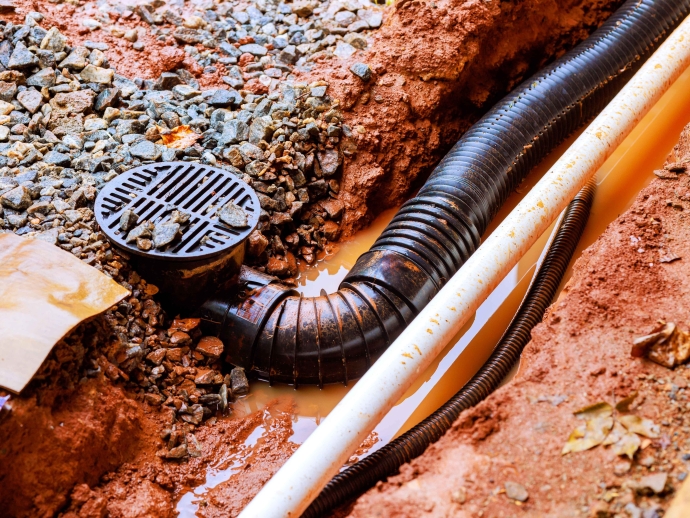Innovative Drainage Solutions for DFW Green Roofs: Managing Flash Floods

The Dallas-Fort Worth (DFW) area is known for its unpredictable weather, including sudden flash floods that can overwhelm traditional drainage systems. Green roofs, with their ability to absorb and retain rainwater, offer a unique solution for managing stormwater runoff. However, they require innovative drainage strategies to prevent water accumulation and ensure structural integrity. This guide explores local rainfall patterns, water retention systems, and flood prevention strategies to help maximize the efficiency of DFW green roofs.
Local Rainfall Patterns
DFW experiences a mix of dry spells and intense rainfall events, making effective drainage crucial:
-
Flash Floods: The region's flat terrain and rapid urbanization contribute to flash flooding risks. Increased impermeable surfaces, such as roads and buildings, exacerbate runoff problems, overwhelming drainage infrastructure. Green roofs can help mitigate these risks by absorbing rainwater and slowing runoff, reducing pressure on storm drains.
-
Seasonal Variations: Summer months often bring heavy thunderstorms, leading to short but intense downpours. Spring and fall experience more consistent rainfall, while winters remain relatively dry. Understanding these patterns allows architects and engineers to design drainage systems that accommodate varying precipitation levels throughout the year.
Water Retention Systems
Green roofs incorporate several components to manage water retention effectively:
-
Drainage Layers: These layers are essential for directing excess water toward designated drainage points without compromising the structural integrity of the roof. Drainage layers typically consist of geotextile fabrics, lightweight aggregates, and perforated panels that facilitate efficient water flow.
-
Waterproofing Membranes: High-quality waterproof membranes are crucial in preventing leaks and protecting the building’s structure from water damage. These membranes must be durable, resistant to root penetration, and capable of withstanding extreme weather conditions to ensure longevity.
-
Rainwater Harvesting: Integrating rainwater harvesting systems with green roofs provides an opportunity to collect and reuse rainwater for irrigation, cooling systems, and other non-potable water applications. Storage tanks or underground cisterns can be installed to capture excess runoff, reducing the burden on local drainage infrastructure.
-
Retention and Detention Systems: Retention systems store rainwater temporarily, allowing for gradual release into drainage networks, while detention systems prevent excessive accumulation of water, ensuring stability and preventing waterlogging. A combination of both strategies can optimize stormwater management in urban areas prone to flash floods.
Flood Prevention Strategies
To prevent flooding on green roofs and ensure optimal drainage performance, the following strategies should be employed:
-
Slope and Drainage Design: A well-designed slope ensures water is directed toward designated drainage points efficiently. Tapered insulation systems can help create the necessary gradient on flat roofs. A minimum slope of 2% is typically recommended to facilitate proper drainage.
-
Permeable Materials: The incorporation of permeable materials, such as AirDrain grids and porous substrates, improves water infiltration and reduces the risk of ponding. These materials allow rainwater to percolate through the growing medium and drainage layer, enhancing overall drainage efficiency.
-
Vegetation Selection: Choosing the right vegetation is crucial for green roof performance. Drought-resistant plants with high water absorption capabilities, such as sedum, native grasses, and succulents, can help regulate moisture levels and reduce runoff. A diverse plant selection also promotes biodiversity and enhances the aesthetic appeal of green roofs.
-
Modular Drainage Systems: Prefabricated modular systems simplify green roof installation and provide efficient drainage solutions. These systems feature interconnected panels designed to store, filter, and redirect excess water, preventing excessive accumulation and structural damage.
-
Regular Maintenance: Routine inspections and maintenance ensure that drainage systems remain clear of debris and functioning optimally. This includes checking for clogged drains, inspecting waterproof membranes for signs of wear, and trimming vegetation to prevent overgrowth that could impede water flow.
Additional Benefits of Green Roof Drainage Solutions
Beyond managing stormwater, innovative drainage solutions for green roofs contribute to several other environmental and economic benefits:
-
Urban Heat Island Mitigation: Green roofs help lower ambient temperatures in urban areas by absorbing solar radiation and reducing heat buildup. Efficient drainage systems ensure that green roofs remain functional during extreme weather conditions, enhancing their cooling effect.
-
Air Quality Improvement: Plants on green roofs filter pollutants from the air, improving overall air quality in urban environments. Proper drainage prevents excessive moisture buildup, reducing the risk of mold and mildew growth that could compromise air quality.
-
Structural Longevity: By preventing water accumulation and minimizing freeze-thaw cycles, green roof drainage systems protect building structures from water-related damage, extending their lifespan and reducing maintenance costs.
-
Stormwater Fee Reductions: Many municipalities offer incentives, such as reduced stormwater fees, for properties implementing effective stormwater management practices. Installing a green roof with an advanced drainage system can help property owners qualify for these benefits.
Conclusion
Innovative drainage solutions for DFW green roofs are essential for managing flash floods and ensuring the longevity of these sustainable systems. By understanding local rainfall patterns, implementing effective water retention systems, and employing advanced flood prevention strategies, green roofs can play a crucial role in reducing stormwater runoff and mitigating flood risks. Additionally, these solutions contribute to urban sustainability, enhancing air quality, reducing heat islands, and improving the overall resilience of buildings. Investing in well-designed green roof drainage systems not only protects property but also promotes a healthier and more sustainable urban environment for the Dallas-Fort Worth area.

